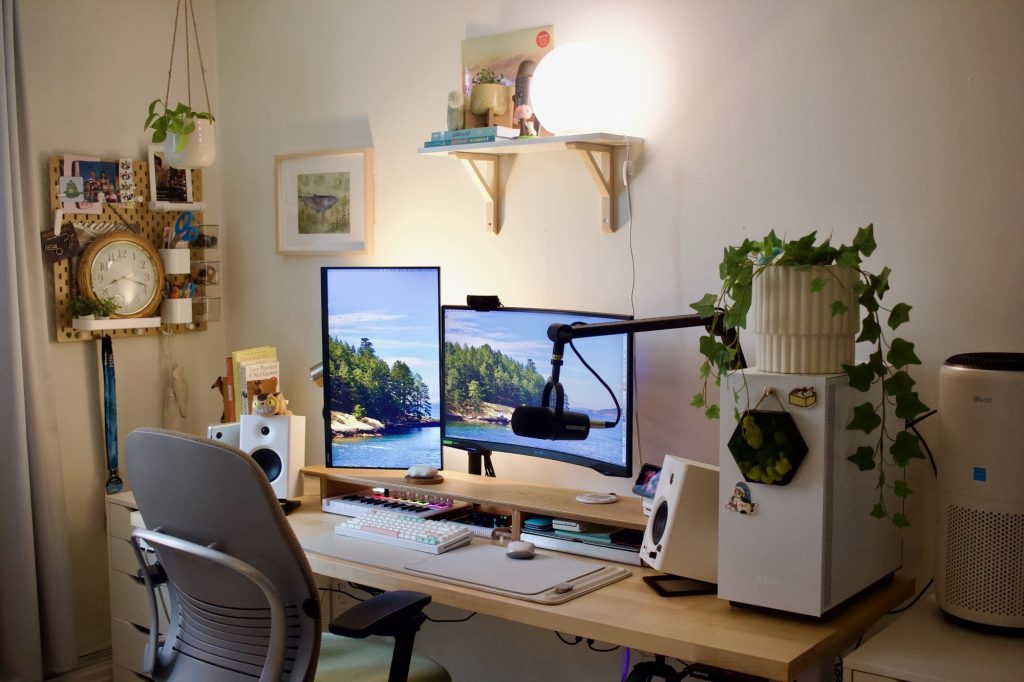Home Office Setups That Encourage Productivity
Jessica White August 19, 2025
Remote and hybrid work have reshaped how people think about productivity, focus, and collaboration. By 2025, the conversation has shifted away from simply setting up a desk at home. Instead, workers and organizations are exploring how new approaches—such as virtual co-working (also known as body-doubling) and quiet computing—can make home offices more effective.
Both trends are gaining momentum because they address two of the most common challenges of working from home: the lack of accountability and the constant battle against noise and distraction. This article explores how these trends are shaping the future of productivity, how to implement them in your own home office, and why they matter in the evolving landscape of hybrid work.
The focus keyphrase virtual co-working and quiet computing appears throughout this article, as it captures the core trends reshaping home office setups that encourage productivity.

1. The Rise of Virtual Co-Working (“Body-Doubling”)
What Is Virtual Co-Working?
Virtual co-working, often called body-doubling, is a practice where individuals log into a video call or digital space to work independently yet together. The purpose is not collaboration but accountability. Just as studying in a library makes it easier to stay focused, having another person present—even virtually—can help reduce procrastination and increase concentration.
This trend first gained traction among individuals with ADHD, as many found that the presence of another person improved their ability to initiate and sustain tasks. However, by 2025, it has moved into the mainstream. Professionals across industries now use virtual co-working to reintroduce social accountability into their home office routines.
Why It Works
- Accountability: The simple awareness that another person is present can reduce distractions.
- Momentum: Seeing others engaged in their work creates a sense of shared purpose.
- Reduced Loneliness: Remote work can feel isolating; co-working restores a sense of community.
- Structure: Virtual co-working often uses time blocks (like the Pomodoro technique), which reinforce focus.
Real-World Examples
- Tech startups are hosting internal co-working sessions where employees log in for silent work blocks.
- Freelancers are joining online platforms dedicated to body-doubling, where strangers keep each other accountable.
- Some organizations now include optional virtual co-working in their wellness and productivity programs.
How to Implement Virtual Co-Working at Home
- Choose a platform: Zoom, Google Meet, or specialized co-working apps.
- Set expectations: State what you’ll work on and for how long.
- Use intervals: Work for 25–50 minutes, then take short breaks together.
- Keep conversation minimal: The goal is silent accountability, not brainstorming.
- Find consistency: Schedule recurring sessions for better results.
2. Quiet Computing: Designing Spaces for Focus
The Concept
Quiet computing refers to creating a work environment that minimizes noise and digital distraction. Originally used to describe workplace design in open-plan offices, the concept is increasingly applied to home offices.
The core principle is that mental performance improves in spaces with controlled auditory and environmental stimuli. Excessive noise has been linked to stress, reduced productivity, and cognitive fatigue. Quiet computing provides a counterbalance by intentionally shaping environments for clarity and calm.
Benefits of Quiet Computing
- Reduced fatigue: Less noise means less mental energy spent filtering distractions.
- Increased focus: A quieter workspace supports deep, sustained concentration.
- Enhanced well-being: Lower noise exposure is linked to reduced stress and better mental health.
- Improved satisfaction: Workers feel more in control of their environment.
Practical Quiet Computing Strategies for Home Offices
- Acoustic Adjustments: Add rugs, curtains, or bookshelves to absorb sound.
- Noise-Canceling Headphones: Essential for blocking out household or street noise.
- Sound Masking Tools: Use white noise machines or apps to create a consistent background.
- Digital Quiet Mode: Set devices to “Do Not Disturb” during focus hours.
- Ritualized Quiet Time: Establish regular “quiet hours” in your household.
3. Why Virtual Co-Working and Quiet Computing Work Together
While virtual co-working provides accountability and human presence, quiet computing ensures an environment where that accountability translates into productive focus. The two trends complement each other:
- Virtual co-working gives external motivation.
- Quiet computing gives internal calm and clarity.
Together, they tackle the dual challenges of remote work—distraction and isolation.
4. The Bigger Picture: Productivity in the Hybrid Era
Shifts in Workplace Norms
Hybrid work has become the dominant model by 2025. Many employees split time between home and the office, and companies have learned that productivity does not necessarily require constant physical presence. Research shows remote work often maintains or even boosts productivity when supported by good setups.
Why These Trends Matter Now
- AI and automation have increased the number of digital tasks. Workers need deeper focus to manage more complex problem-solving.
- Mental health awareness has made organizations more open to strategies that reduce stress and improve employee experience.
- Flexibility is no longer a perk but a baseline expectation; employees want home offices that genuinely work.
5. Step-by-Step Guide: Building Your Home Office with These Trends
Here’s how to integrate virtual co-working and quiet computing into a practical, productivity-friendly home office.
1: Define Your Workspace
- Choose a dedicated zone with minimal foot traffic.
- Use partitions if sharing space with others.
2: Address Noise and Distraction
- Add soft furnishings for acoustic benefits.
- Invest in quality headphones with active noise cancellation.
- Use white noise or ambient tracks to mask sudden sounds.
3: Layer Accountability
- Join or start a virtual co-working group.
- Use time-blocking apps to structure focus sessions.
- Check in with co-workers or peers on shared goals.
4: Establish Daily Rituals
- Begin each day by setting intentions.
- Silence unnecessary notifications.
- Take restorative breaks away from your screen.
5: Review and Adapt
- Track your productivity weekly.
- Adjust co-working frequency or quiet computing tools based on your workflow.
6. The Human Side of Productivity
Both trends highlight that productivity is not simply about squeezing out more work. It’s about creating conditions where work feels sustainable and mentally rewarding.
- Virtual co-working underscores our need for human connection, even in remote contexts.
- Quiet computing emphasizes the value of peace and focus in a world filled with noise.
7. Looking Ahead
As hybrid and remote work continue to evolve, these practices are likely to become standard features of modern home offices. We may see:
- More platforms built for virtual co-working.
- Better sound design integrated into home office furniture.
- Employer support in providing stipends for noise-control tools or co-working memberships.
Ultimately, virtual co-working and quiet computing are not fleeting productivity hacks. They represent a cultural shift in how people design work environments that align with human psychology and the realities of remote work.
Conclusion
Home offices in 2025 are no longer just about ergonomics and internet speed. The new frontiers of productivity lie in creating conditions that encourage focus, accountability, and well-being. Virtual co-working and quiet computing address these needs directly, offering practical and research-backed solutions for today’s hybrid workforce.
By combining the presence of others with the calm of silence, remote workers can transform their spaces into high-performance environments that support both professional output and personal well-being. The future of productivity is not louder or busier—it is smarter, quieter, and more connected.
References
- Wikipedia. (2025). Quiet computing in open-plan offices. Available at: https://en.wikipedia.org (Accessed: 19 August 2025).
- Skedda. (2025). Modern workplace trends in 2025. Available at: https://www.skedda.com (Accessed: 19 August 2025).
- News.com.au. (2025). Productivity Commission backs hybrid work-from-home model. Available at: https://www.news.com.au (Accessed: 19 August 2025).






